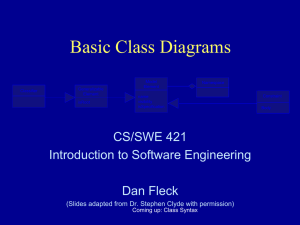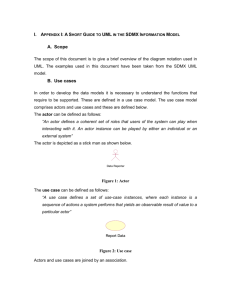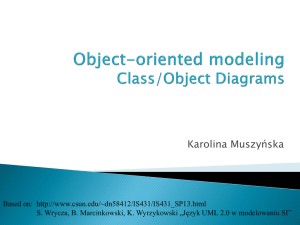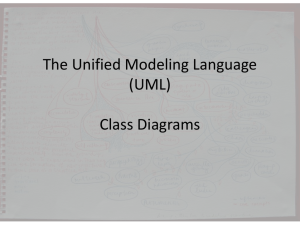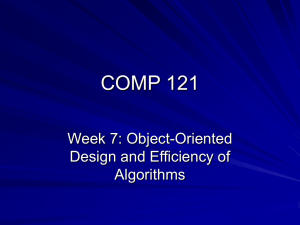slides - People Server at UNCW - University of North Carolina
advertisement
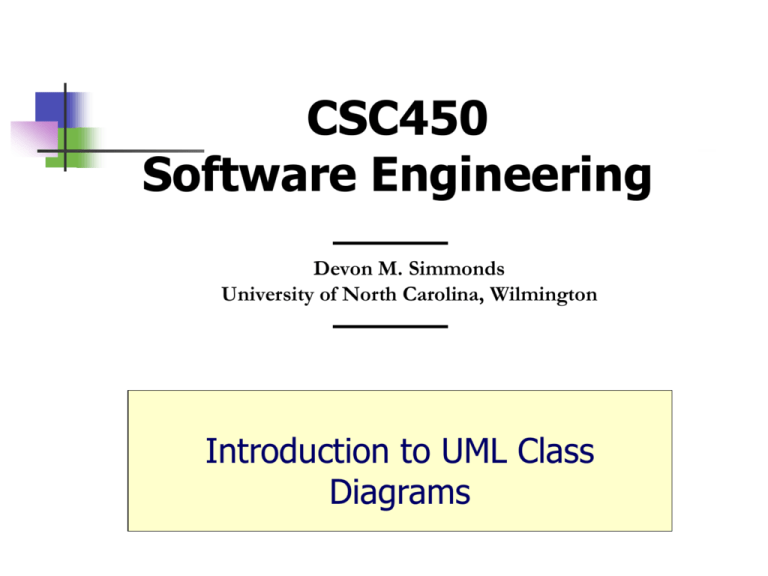
CSC450
Software Engineering
Devon M. Simmonds
University of North Carolina, Wilmington
Introduction to UML Class
Diagrams
Objectives
Introduce basic class diagram constructs
Introduce UML relationships
Generalization
Association
Aggregation/composition
Dependency
Interfaces
What is a class?
A class is a description of a set of
objects that share the same properties
attributes
Operations
Java class
public class Student {
int id;
Address addr;
int graduate (String semester)
}
UML class
Student
Id:Integer
addr:Address
graduate(semester:String):int
Structure of a class
A class has the following structure:
Name compartment (mandatory)
Attributes compartment (optional)
Operations compartment (optional)
Every class must have a
distinguishing name.
An object is an instance of a class
An object of a class must have values
associated with each attribute of the
class
Name
attributes
operations
Student
Id:Integer
Addr:String
graduate(semester:String):int
johnWayne:Student
Id = 2007
Addr = “Wild Wild West”
Class Notation
name
attributes
operations
Rectangle
Rectangle
height
width
attributes
operations
Rectangle
getArea
resize
Rectangle
height
width
getArea
resize
Attributes
Window
size:Area
visibility:Boolean
display()
hide()
An attribute is a named property. Each class instance
associates value(s) with each attribute of a concept.
What should be an attribute?
Properties with types that we want to treat as primitive are
modeled as attributes
Connections to other classes are to be represented as
associations, not attributes.
Operations
An operation is a procedure defined in a class.
Each operation has a signature and a specification of
its behavior.
Signature: operation name, a list of argument types and the
result type.
operationName(parameterName: parameterType …): returnType
Specification is expressed in terms of pre-and postconditions
(the Object Constraint Language is used for this purpose)
Operations II
A method is the implementation of an
operation.
Classes in requirements and domain
models DO NOT NEED to contain
operations
Rationale: in most cases, distributing
operations across classes requires making
design-level decision.
Objectives
Introduce basic class diagram constructs
Introduce UML relationships
Association
Aggregation/composition
Generalization
Dependency
UML Interfaces
Modeling Static Class
Relationships
Association
Aggregation/composition
Generalization
Dependency
10
Associations
Associations represent conceptual
relationships among problem concepts
or classes.
Association properties include
Multiplicity
Role
Constraints
Associations
-"direction reading arrow"
-it has no meaning except to indicate direction of
reading the association label
-often excluded
Employee 1
works-for4
3
Company
multiplicity
Association name
Multiplicity
*
Student
zero or more;
"many"
Customer
1..*
1..40
Student
one or more
0..1
Rents 6
Student
one to forty
*
5
3, 5, 8
Student
exactly five
Student
exactly three,
five or eight
Video
One instance of a
Customer may be renting
zero or more Videos.
One instance of a Video
may be being rented by
zero or one Customers.
Association Multiplicity Examples
Employee
*
Secretary
*
Company
1..**
Company
Office
Person
Manager
BoardOfDirectors
0..1
0,3..8
*
*
Employee
BoardOfDirectors
Labelling associations
Each association can be labelled with a name that
gives insight into the meaning of the association
Employee
*
Secretary
*
w orksFor
Company
1..**
Manager
supervisor
Company
Office
Person
BoardOfDirectors
0..1
0,3 ..8
boardMember
allocatedTo
*
*
Employee
BoardOfDirectors
Association Roles
When a class is part of an association it
plays a role in the relationship.
You can name the role that a class
plays in an association by placing the
name at the class’s association end.
Formally, a class role is the set of
objects that are linked via the
association.
class roles
project leader
Person
1
1..*
project member
managed
project
0..1
assigned
project
*
Project
Analyzing and validating
associations
Many-to-one
A company has many employees,
An employee can only work for one company.
A company can have zero employees
E.g. a ‘shell’ company
It is not possible to be an employee unless you
work for a company
Employee
*
w orksFor
Company
Analyzing and validating
associations
Many-to-many
A secretary can work for many managers
A manager can have many secretaries
Secretaries can work in pools
Managers can have a group of secretaries
Some managers might have zero secretaries.
Is it possible for a secretary to have, perhaps
temporarily, zero managers?
Secretary
*
1..**
supervisor
Manager
Analyzing and validating
associations
One-to-one
Company
For each company, there is exactly one board
of directors
A board is the board of only one company
A company must always have a board
A board must always be of some company
BoardOfDirectors
Do Not Use Attributes
To Relate Concepts
Customer
Video
Worse
rentedVideos: List of Video
Customer
Better
...
1
renter : Customer
Rents4
1..*
Video
...
Reflexive associations
It is possible for an association to connect
a class to itself
successor
* Course
*
prerequisite
*
*
isMutuallyExclusiveWith
Navigability
One can indicate that an object “knows
about” another object it is linked to by
using navigation arrows on associations
In UML 2.0 one can also explicitly show
that one object does not know about the
objects it is linked to.
The constructs in
diagrams 1, 2, and
4 are new to UML
2.0 and thus are
most likely not
supported by UML
tools as yet.
•The top pair AB shows a binary association with two navigable ends.
•The second pair CD shows a binary association with two non-navigable ends.
•The third pair EF shows a binary association with unspecified navigability.
•The fourth pair GH shows a binary association with one end navigable and the other
non-navigable.
•The fifth pair IJ shows a binary association with one end navigable and the other having
unspecified navigability.
Actions versus associations
A common mistake is to represent actions
as if they were associations
LibraryPatron
*
*
*
borrow
Loan
return
*
*
CollectionItem
Bad, due to the use of
associations that are
actions
*
borrowedDate
dueDate
*
returnedDate
LibraryPatron
CollectionItem
Better: The borrow operation creates a
Loan and the return operation sets the
returnedDate
What is a Class Diagram?
A class diagram describes a structure of
classes
Key Question: What are the objects of
interest in the problem/solution space?
their properties (in terms of attributes and
operations)?
their relationships?
An example of a Class Diagram
description of problem concepts
0..1
Rents4
Customer
address
name
phoneNumber
*
VideoStore
Rents-from 4
*
1
address
name
phoneNumber
1..2
HeadOffice
Video
Stocks4
1
*
ID
*branchOffice
The above is part of a domain model for a video rental system
Objects and Links
An object is an instance of a class
A link is an instance of an association
0..1
Rents4
Customer
address
name
phoneNumber
VideoStore
Rents-from 4
*
1
address
name
phoneNumber
1..2
HeadOffice
*
Video
Stocks4
1
*
ID
*branchOffice
Can you draw a valid object diagram for
this class diagram?
Association: Model to Implementation
Student
*
istakenby
4
Course
enrolls
Class Student {
Course enrolls[4];
}
Class Course {
Student istakenby[];
}
29
Association: Model to Implementation
Student
*
has
4
Course
enrolls
Class Student {
Course enrolls[4];
}
30
Class Exercise
Create a class diagram that reflects
concepts for a typical student at a
university.
Modeling Static Class
Relationships
Association
Aggregation/composition
Generalization
Dependency
32
Aggregation
Aggregation is a special form of
association
reflect whole-part relationships
The whole delegates responsibilities to
its parts
the parts are subordinate to the whole
This is unlike associations in which classes
have equal status
UML Forms of Aggregation
Composition (strong aggregation)
parts are existent-dependent on the whole
parts are generated at the same time,
before, or after the whole is created
(depending on cardinality at whole end)
and parts are deleted before or at the
same time the whole dies
multiplicity at whole end must be 1 or 0..1
(weak) Aggregation
Composition
– black diamond notation
Window
1
1
scrollbar
Slider
2
1
title
1
Header
body
1
Panel
OO Relationships: Composition
Composition: expresses a relationship among instances
of related classes. It is a specific kind of Whole-Part
relationship.
Whole Class
It expresses a relationship where an instance of the
Whole-class has the responsibility to create and initialize
instances of each Part-class.
Class W
Class P2
Class P1
Part Classes
It may also be used to express a relationship where instances
of the Part-classes have privileged access or visibility to
certain attributes and/or behaviors defined by the
Whole-class.
Composition should also be used to express relationship where
instances of the Whole-class have exclusive access to and
control of instances of the Part-classes.
Example
Automobile
Engine
Composition should be used to express a relationship where
the behavior of Part instances is undefined without being
related to an instance of the Whole. And, conversely, the
behavior of the Whole is ill-defined or incomplete if one or
more of the Part instances are undefined.
Transmission
[From Dr.David A. Workman]
36
OO Relationships: Aggregation
Container Class
Class C
Aggregation: expresses a relationship among instances
of related classes. It is a specific kind of ContainerContainee relationship.
AGGREGATION
Class E1
Class E2
Containee Classes
Example
Apples
Bag
It expresses a relationship where an instance of the
Container-class has the responsibility to hold and maintain
instances of each Containee-class that have been created
outside the auspices of the Container-class.
Aggregation should be used to express a more informal
relationship than composition expresses. That is, it is an
appropriate relationship where the Container and its
Containees can be manipulated independently.
Aggregation is appropriate when Container and
Containees have no special access privileges to each other.
Milk
37
[From Dr.David A. Workman]
Aggregation vs. Composition
•Composition is really a strong form of aggregation
•components have only one owner
•components cannot exist independent of their owner
•components live or die with their owner
e.g. Each car has an engine that can not be shared with
other cars.
•Aggregations may form "part of" the aggregate, but may not
be essential to it. They may also exist independent of the
aggregate.
e.g. Apples may exist independent of the bag.
38
Modeling Static Class
Relationships
Association
Aggregation/composition
Generalization
Dependency
39
Generalization/Specialization
A generalization (or specialization) is a
relationship between a general concept
and its specializations.
Objects of specializations can be used
anywhere an object of a generalization is
expected (but not vice versa).
Example: Polygon and Ellipse are
specializations of Shape
Shape
Separate Target Style
Generalization
Polygon
Ellipse
Spline
. ..
Rendering Generalizations
Generalization is rendered as a solid directed
Shape
line with a large open arrowhead. Shared Target Style
Arrowhead points towards generalization
A discriminator can be used to identify the
nature of specializations
Polygon
Ellipse
Spline
...
Generalization
Vehicle
venue
power
power
{overlapping}
WindPowered
Vehicle
Truck
venue
MotorPowered
Vehicle
Sailboat
{overlapping}
Land
Vehicle
Fig. 3-48, UML Notation Guide
Water
Vehicle
An example (generalization)
PersonRole
0..2
Person
name
idNumber
RegularFlight
*
EmployeeRole
PassengerRole
jobFunction
supervisor
*
*
Booking
seatNumber
*
*
*
SpecificFlight
date
time
flightNumber
Object Diagram - Example
Organism
location
* children
0..1 parent
Person
Organization
Engineering:Organization
Location=“chicago”
Apps:Organization
Tools:Organization
location=“Wilmington”
Location=“chicago”
manager
employee
don:Person
charlene:Person
location=“Raleigh”
location=“denver”
44
Association end constraints
Binary and N-ary Associations
A binary association relates two classes.
An n-ary association relates n (n > 2)
classes.
N-ary associations can often be
modeled as binary associations.
Can you interpret the following?
Class Diagram Exercise
Create a use case diagram and a class diagram using the
problem description below.
The BirdCage Corporation needs software to aid the management of its
business. The corporation builds its business around domestic birds. BirdCage
arranges its business around different services with each service being managed
by a different company making BirdCage a group of companies. Companies are
divided into departments. Services include veterinary services, safekeeping of
birds, bird calisthenics and a bird competitions service. In order to streamline its
business, BirdCage classifies the veterinary and safekeeping services as medical
services. The other two services are regarded as entertainment services. In the
future the company hopes to add a number of “Nutritional” services to address
the production and sales of food for birds. The corporation classifies birds as
either exotic or non-exotic. BirdCage does not provide entertainment services
for exotic birds. Owls and crows are non-exotic birds, while macaws, cockatoos
and green quakers are exotic. BirdCage seeks to maintain a minimum stock of at
least 10 of each type of exotic bird.
Modeling Static Class
Relationships
Association
Aggregation/composition
Generalization
Dependency
49
Dependencies in UML
A dependency is a client-server
relationship between model elements.
A dependency is shown as a dashed
arrow between two model elements.
The server is at the arrowhead.
The arrow may be labeled with an optional
stereotype.
50
Dependencies Notation in UML
51
Realization Dependencies
52
Usage Dependencies
53
Objectives
Introduce basic class diagram constructs
Introduce UML relationships
Generalization
Association
Aggregation/composition
Dependency
UML Interfaces
Interfaces in UML
An interface is a named collection of
operations that represent the services
provided by a class or component.
Interfaces do not typically have
attributes.
Interfaces do not provide
implementations for their operations.
55
Example of an interface
Interface
operation1( ) : Type1
operation2( ) : Type2
operation3( ) : Type3
operation4( ) : Type4
operation5( ) : Type5
56
UML Notation for Interfaces
Usage Dependency
Realization Dependency
An interface may be identified using the <<interface>>
keyword preceding the name of the interface.
Classes that use the interface can have two types of
relationships or dependencies
Interface realization
Usage
57
UML Notation for Interfaces
Usage
Interface realization means ProximitySensor implements the
operations defined by ISensor.
Interface Realization
ISensor is called a provided interface for ProximitySensor.
Interface usage means TheAlarm uses the operations defined
by ISensor.
ISensor is called a requiredinterface for TheAlarm.
58
Interfaces: Dependency
Provided Interface
Realization Dependency
Required Interface
Usage Dependency
59
Interfaces: Dependency
“Ball-and-socket” notation
Required Interface
Usage Dependency
Provided Interface
Realization Dependency
ISensor
60
What does this model mean?
IAlarm is a provided interface for
ISensor.
ISensor is a provided interface for
IAlarm .
61
What does this model mean?
IBuzzer is a provided interface for
IAlarm .
…
62
Summary
In this lecture we:
Introduced basic class diagram constructs
Relationships in UML
Association/aggregation/composition/dependency
UML Interfaces
What’s coming next class?
Qu es
ti ons?
______________________
Devon M. Simmonds
Computer Science Department
University of North Carolina Wilmington
_____________________________________________________________
64

